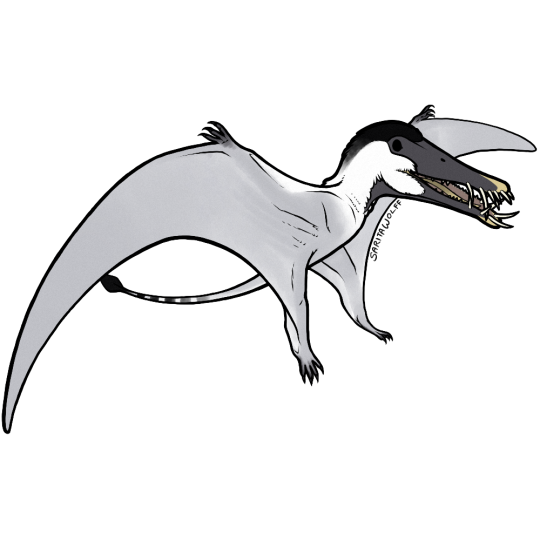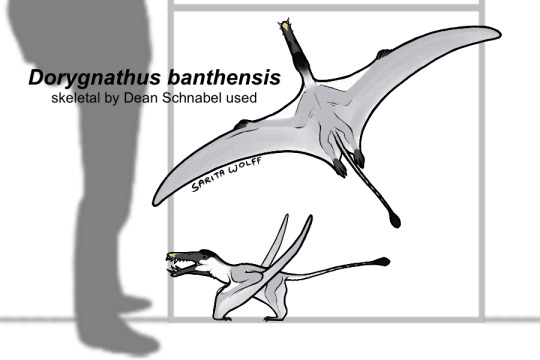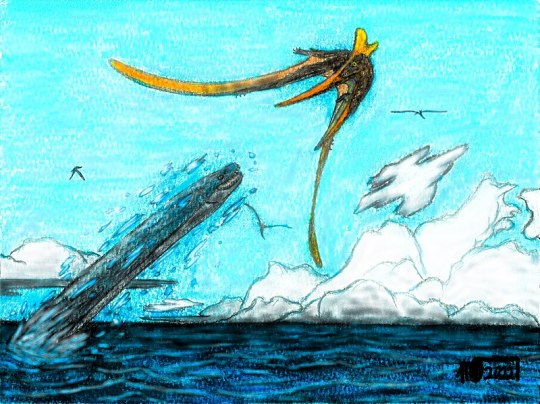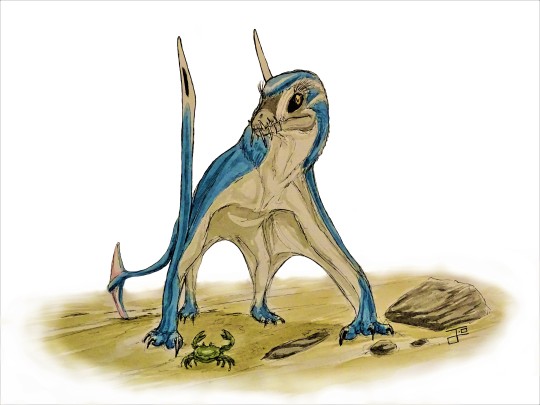#Rhamphorhynchid
Explore tagged Tumblr posts
Text


From my first ever flocking paleostream! :D
Sordes and the neighbors fighting over an unexpected find. While none of those animals are dedicated scavangers, this ornithopod carcass was too good to miss.
#paleoart#paleostream#sordes#pterosaur#pterosaurs#rhamphorhynchid#jurassic period#batrachognathus#anurognathus#well... Not exactly but an anurognathid nonetheless#dinosaur#enantiornithes#my art#watercolour
25 notes
·
View notes
Text

#Archovember Day 13 - Dorygnathus banthensis
Dorygnathus banthensis was a rhamphorhynchid that lived in the Early Jurassic of Europe, also in the time of the early Tethys Sea taking up most of the continent. (I did not realize I had put so many of these Jurassic archosaurs this close together when I made this list! We’ll be getting something from the Cretaceous tomorrow, don’t worry.) Like other rhamphorhynchids, it had a short neck, a long tail, and large interlocking fangs for catching and gripping wriggling fish. Wear on the teeth of some specimens suggest that they may have also fed on hard-shelled prey like mollusks and crustaceans. One specimen also contains preserved hairs, further evidence of pycnofibers or feathers in all pterosaurs.

Dorygnathus was more common in its environment than its contemporary Campylognathoides, and both have been found in marine deposits suggesting they regularly traveled over open sea. Dorygnathus would have lived alongside our previously visited Macrospondylus bollensis as well as other teleosauroids like Mystriosaurus, Pelagosaurus, and Platysuchus. It would have come across sauropods like Ohmdenosaurus, and flown over the variety of Early Jurassic ocean life like icthyosaurs, small plesiosaurs, early sharks, ammonites, and much more.
#my art#SaritaDrawsPalaeo#Dorygnathus banthensis#Dorygnathus#Rhamphorhynchid#pterosaurs#archosaurs#archosauromorphs#Archovember#Archovember2023
22 notes
·
View notes
Text

Pterosaurs.

A closer look at Scaphognathus.
24 notes
·
View notes
Text
Patreon request for @/rome.and.stuff (Instagram handle) - Saurophaganax maximus

Saurophaganax maximus was an allosaurid from Late Jurassic Oklahoma, USA. Reaching 10.5 metres (34 ft) in length and weighing 2.7–3.8 metric tons (3.0–4.2 short tons), it was the largest terrestrial carnivore in North America during the Late Jurassic, bigger than both its contemporaries Torvosaurus tanneri and Allosaurus fragilis. Some scientists argue that it was in fact a species of Allosaurus (making it “Allosaurus maximus”), but possible Saurophaganax material found in New Mexico may shed light on the genus. With a name meaning "lord of lizard-eaters", it was likely the apex predator of its environment.

Found in the Brushy Basin member of the Morrison Formation, Saurophaganax would have had a multitude of prey species to choose from. These ranged from small ornithischians like Camptosaurus, Dryosaurus, and Fruitadens, armoured thyreophorans like Gargoyleosaurus, Mymoorapelta, Hesperosaurus, and Stegosaurus, to a diverse array of giant sauropods like Haplocanthosaurus, Amphicoelias, Apatosaurus, Brontosaurus, Barosaurus, Diplodocus, Kaatedocus, Supersaurus, Brachiosaurus, and Camarasaurus. Small theropods included Coelurus, Hesperornithoides, Tanycolagreus, and Ornitholestes.
The Morrison didn’t only have a large diversity of dinosaurs. Many pseudosuchians lived alongside Saurophaganax, from the skittering, long-legged Hallopus to the more aquatic Amphicotylus. Pterosaurs were uncommon but widespread, and included rhamphorhynchids like Harpactognathus and ctenochasmatids like Kepodactylus. Other reptiles like rhynchocephalians, lizards, basal snakes, and turtles were common as well. Many cynodonts, mostly early mammals, also called the Morrison home.
The Morrison Formation was also rife with other large predators that could have been either competitors or prey to Saurophaganax themselves. These include the previously mentioned Allosaurus and Torvosaurus, as well as the smaller Ceratosaurus nasicornis and Marshosaurus bicentesimus. As Allosaurus seemed to be the most numerous predators in this formation, they may have been successful pack hunters while Saurophaganax was more of a “lone wolf.” Its remains are much rarer than that of its smaller, lither cousins, and it was likely an opportunistic scavenger and hunter, needing much more food to power its larger frame.

This art may be used for educational purposes, with credit, but please contact me first for permission before using my art. I would like to know where and how it is being used. If you don’t have something to add that was not already addressed in this caption, please do not repost this art. Thank you!
#Saurophaganax maximus#Saurophaganax#allosaurid#allosauroid#theropods#saurischians#dinosaurs#archosaurs#archosauromorphs#reptiles#SaritaDrawsPalaeo#Morrison Formation#Late Jurassic#North America
15 notes
·
View notes
Text
An experiment with pen.
Last year I decided to conduct an experiment. Its essence was to draw an animal based on a reference, but using only a pen when creating a sketch. As a result, I made these two drawings.

It is a rhamphorhynchid pterosaur Bellubrunnus rothgaengeri from the Late Jurassic of Southern Germany. It is known for a small individual less than a year old. Its characteristic feature is the forward-curving terminal phalanges of the fourth finger which supports a patagium. In the process of creating the drawing, I encountered difficulties in conveying the position of the left wing in space. I had to use white gouache and make corrections so that the drawing didn't look too distorted.

The second drawing is a megalosaurid theropod Dubreuillosaurus valesdunensis from the Middle Jurassic of France. There were much fewer problems with transferring the shape of the skull to paper, because I am more familiar with theropods as an object of drawing than with pterosaurs. In the previous case, the result was not bad, but I like this portrait more. :) Dubreuillosaurus is known from the incomplete skeleton of a 5 meters long immature individual. At first it was described as a species of the genus Poekilopleuron, but in 2005 it was separated as an independent genus.
Both drawings are made with black ballpoint pen.
#bellubrunnus#rhamphorhynchus#rhamphorhynchidae#pterosaurs#dubreuillosaurus#megalosaurus#megalosauridae#theropod#theropod lips#jurassic period#paleoart
5 notes
·
View notes
Text
Where and how did pteranodontians come to be?

Epapetelo by SpinoDragon145
Pteranodontians are a famous clade of Late Cretaceous pterosaurs that include the titular Pteranodon, the nyctosaurs and taxa that sometimes are either pteranodontids or nyctosaurids like Volgadraco. They dominate the Late Cretaceous oceanic environments, seemingly replacing the closely related ornithocheiromorphs and other toothed piscivorous pterosaurs.
Strangely, they appear almost ad nihilo, suddenly bursting into the fossil reccord with no intermediary forms with other pterosaur groups. So, how did these pterosaurs evolve?
In most cladograms, they appear as sister taxa to Ornithocheiromorpha. Seeing as ornithocheiromorphs were around the earliest Cretaceous, this would suggest a ghost lineage of almost 50 million years. Unless early pteranodontians were small aerial insectivores or something, such a ghost lineage appears odd. It may however be corroborated by a Berriasian nyctosaur humerus (Naish et al 2010), assuming it is from a nyctosaur and not from a late surviving rhamphorhynchid (which had similar triangular deltopectorals) or something else entirely.
More likely is that these animals evolved much late and from within the Ornithocheiromorpha, which would make this group paraphyletic in regards to Pteranodontia. After all, both groups are dictated only by morphological traits (the relatively "primitive" ornithocheiromorphs lining together against the "derived" pteranodontians) and there's no way to get genetic analyses. An origin within Ornithocheiromorpha would lessen the degree of the ghost lineage and feel more "natural" than an extended 50 million year ghost lineage.
Within the Ornithocheiromorpha, I find the targaryendraconids to be possible ancestors, sharing upturned jaws with no crests, or alternatively the boreopterids, being freshwater taxa that would have easily survived the Cenomanian mass extinction.
Only further fossils will answer for sure.
12 notes
·
View notes
Photo

I didn't initially get round to illustrating the recently-described Scottish pterosaur, Dearc sgiathanach, so what better day for a watercolour sketch of this impressively large Jurassic rhamphorhynchid than St Andrew's Day!
102 notes
·
View notes
Text
Codex Entry #002 | “Radon kashiwagii” (Rodan)

[This Series is heavily inspired by Trollmans’ “FOLLY OF MAN” series on DeviantArt, so be sure to follow him if you enjoyed my work]
Species: Radon kashiwagii (Rodan) Subtitle: The Fire Demon First Modern Sighting: December 26, 1956 Height: 111.43 Metres Wingspan: 275.082 Metres Weight: 42,634.601 Tonnes
It is currently believed that the Rodan species diverged from rhamphorhynchid pterosaurs sometime in the Mid-Jurassic. It is believed that its ancestors nested within volcanoes and gradually developed a bio-volcanic nature through bursts of G-radiation occasionally emitted through underground caves and tunnels within these volcanoes. As with most kaiju, the cell structure of rodan are similar in shape and function to G-cells, though there are many key differences. It is theorized that these creatures feed off of radiation like the Godzilla species, though this appears to be far less efficient being done through their lower wings and middle crest. So far, most specimens found have been adolescents (pictured above). Few juveniles have been found, they seem to exhibit far brighter colors and lack any form of storing or releasing radiation. Due to this, the young form large flocks and have been known to hunt small whale species. Rodan become darker as they age, which may hypotetically culminate in a near pitch-black full-grown form.
Rodan exhibit corvid-like levels of intelligence, and can replicate many sounds. Documents exist of Rodan mimicking the sounds of whales, fog horns, earthquakes, storms, and even other kaiju. It’s additionally been discovered that the species are able to communicate with other species through a variety of vocalizations and gesturing. Due to the large size and high speeds of rodan, their flight causes supersonic shockwaves that can cause Tsunamis and even topple skyscrapers when flying low. Rodan seem to be preyed upon by other kaiju and have developed numerous offensive and defensive capabilities as a result. They’ve learned to expel radiation through their mouths creating scorching “heat beams” akin to godzilla’s atomic breath. The species has also learned to create distortions in the air, manipulating the electric charge of surrounding atoms which creates an effect somewhat similar to that of volcanic lightning. They combine these two attacks together to create a devastating attack dubbed “volcanic lightning rays”.
Due to the bio-volcanic nature of Rodan, their inner organs can reach temperatures of nearly 1’300 degrees Celsius. Though their body insulates most of this heat, it is still vented through their lower wings to prevent internal combustion, allowing for a trail of potential airborne ash and magma to be released during flight. The underbellies of Rodan are also covered in layers of spiked plating to protect against attacks from below.
I hope y’all liked my Rodan codex entry for GODZILLA: Age of Monsters. The story post will be combined with that of another kaiju who’s artwork will be begun soon…
Tune in for more updates and future posts. Peace and love! ✌️🏽
#kaiju#godzilla#gojira#godzilla au#art#artwork#kaiju redesign#godzilla: age of monsters#godzilla fanart#rodan#kaiju art#long post
15 notes
·
View notes
Text

GODZILLA: DOMINATION!
RADON
Artist's commentary: too many full red/orange rodies out there. AND too many dsungaripterid-based rodies too. Have here one that is neither of the above. Based on a Heisei-generation concept art, and on rhamphorhynchids, and maybe some seabird for the face.
9 notes
·
View notes
Text
I'm torn between 'some variety of rhamphorhynchid pterosaur, maybe something in the genus anurognathus' and 'eohippus'
You can have any animal for a pet. Any complications such as “keeping the animal healthy and happy” and “the time and effort it would take to keep happy and healthy pet” and “keeping yourself uneaten” and “the pet I want is kind of extinct” have all been solved perfectly. You don’t have to think of that.
What is your pet?
23K notes
·
View notes
Photo

Rhamphorhynchus 01
Late Jurassic, Europe
A pair of Rhamphorhynchus pterosaurs in the first light of dawn.
Made in Blender.
#paleontology#paleoart#pterosaur#Jurassic#late jurassic#Rhamphorhynchus#rhamphorhynchoid#rhamphorhynchid#pycnofibers#dawn#dusk#Nathan E. Rogers#blender#3d#prehistoric#solnhofen
36 notes
·
View notes
Text
Fenghuangopterus lii

By Franz Anthony, on @franzanth, retrieved from http://www.pteros.com/, a website dedicated to education about Pterosaurs.
A reminder that we will not be able to do every pterosaur until we reach $240 in donations on our patreon, so please donate even a dollar if you can.
Name: Fenghuangopterus lii
Name Meaning: Fenghuang Wing
First Described: 2010
Described By: Lü, Fucha & Chen
Classification: Avemetatarsalia, Ornithodira, Pterosauromorpha, Pterosauria, Macronychoptera, Novialoidea, Breviquartossa, Rhamphorhynchidae, Scaphognathinae
Fenghuangopterus was a Rhamphorhynchid pterosaur from the Tiaojishan Formation of Liaoning, China, living about 160 million years ago in the Oxfordian age of the Late Jurassic. It is known from a single specimen of most of the specimen, though unfortunately the skull is crushed. It had widely spaced teeth, with concave gaps between the teeth which are also narrow. It had a wingspan of about 95 centimeters, with long and narrow wings. Like other members of its family, it had a long and stiffened tail, and it probably was closely related to Scaphagnathus and one of the earliest members of its groups, Scaphognathinae.
Sources:
https://en.wikipedia.org/wiki/Fenghuangopterus
http://www.pteros.com/pterosaurs/fenghuangopterus.html
Shout out goes to @theawkwardmuslimgirl!
#fenghuangopterus#fenghuangopterus lii#pterosaur#pterosaur ptuesday#rhamphorhynchid#palaeoblr#theawkwardmuslimgirl#paleontology#prehistory#prehistoric life#biology#science#nature#factfile
51 notes
·
View notes
Text

#Archovember Day 10 - Megalosaurus bucklandii
Megalosaurus is famous for two things: being the first non-avian dinosaur described and the basis for establishment of the clade “Dinosauria”, and being one of the first “life-size” dinosaur models ever created. Megalosaurus’ inclusion in the Crystal Palace dinosaur model collection greatly increased public interest in dinosaurs, though they certainly did not know much about its life appearance at the time. Most people now know how laughably inaccurate those models were (but hey, they were trying, it was the first time paleoartists had tried to reconstruct an animal from bone fragments!), but not many know about the real animal behind the dino-hype.

Megalosaurus bucklandii lived in Middle Jurassic England. It is the type species of the Megalosaurids, one of the first major radiations of large theropods, and was generally robust and muscular with powerful hind legs, though not as much as its relative Torvosaurus. While all specimens of Megalosaurus are fragmentary, it seems to have had an unusually large head, equipped with a powerful bite built for holding on to struggling prey. Unfortunately, due to the fragmentary nature of this dinosaur’s fossils, we do not actually know much about its life appearance! Most of what we know must be inferred from other Megalosaurids. That being said, while feathers seemed to have been rare in Jurassic theropods, the Late Jurassic theropod Sciurumimus was preserved with traces of feathers. Sciurumimus is thought to be a juvenile Megalosaurid, though this is disputed. So it could go either way, though it was probably not as heavily feathered as the future Cretaceous theropods would be.
As England was broken up by a series of small islands in the Middle Jurassic, Megalosaurus probably used its muscular hind legs for swimming from island to island in search of prey, which it was also well equipped to chase down. As the apex predator of this environment, Megalosaurus would have had its pick of early sauropods like Cardiodon, Cetiosaurus, and Cetiosauriscus, small theropods like Iliosuchus, early stegosaurs like Lexovisaurus, rhamphorhynchid pterosaurs like Klobiodon, marine pseudosuchians like Teleosaurus, small mammals like Amphilestes and Amphitherium, all the way down to washed up fish or crabs along the beach. It would have lived alongside, and possibly competed with, other large theropods like Cruxicheiros and Streptospondylus, though Megalosaurus appears to have been the most common of the three.
#my art#SaritaDrawsPalaeo#Megalosaurus bucklandii#Megalosaurus#Megalosaurid#theropods#saurischians#dinosaurs#archosaurs#archosauromorphs#reptiles#Archovember#Archovember2023
17 notes
·
View notes
Text

Rhamphorhynchus! It looks like it's going "YIPPIEEEEEE!"
13 notes
·
View notes
Photo

oh goose?
updating my goose sona; he is now a little bit less goose and a little bit more Bastardous
also they have goose wings still; im just lazy and didnt feel like drawing feathers
#anthro#clean furry#fursona#sona#goose#he goose/rhamphorhynchid/baboon cross#aka a fucking wierdo#goose sona
12 notes
·
View notes
Note
I noticed all the pterosaurs in PP were the toothless short-tailed variety. Did the long-tailed toothy ones already die out by the late Cretaceous?
Yep, and not just the long-tailed toothy pterosaurs, but almost all pterosaur groups seem to have gone extinct before the end of the Cretaceous! The only remaining pterosaurs (that we know of) were all pterodactyloids, or "short-tailed" pterosaurs. Most pterodactyloids did also have teeth (like Pterodactylus itself for example), but by 66 million years ago only two groups were left, both toothless, and those are the ones that show up in Prehistoric Planet.
There's Pteranodontia, which includes Nyctosauridae (represented in PP by Barbaridactylus and Alcione) and Pteranodontidae (represented by Tethydraco).

And there's Azhdarchidae, which is represented in Prehistoric Planet by Phosphatodraco, the unnamed Mongolian azhdarchids, Quetzalcoatlus, and Hatzegopteryx.

The long-tailed toothy ones used to be grouped together as "rhamphorhynchoids", but this is an unnatural grouping that lumped together early pterosaurs, dimorphodontids, anurognathids and rhamphorhynchids based on them being seen as "more primitive". It's not really a scientifically useful group, but yeah by the Maastrichtian stage of the Cretaceous everything that wasn't a pteranodont or an azhdarchid seems to have been gone.
#prehistoric planet#prehistoric planet spoilers#pterosaurs#paleontology#paleoart#paleomedia#palaeoblr
183 notes
·
View notes